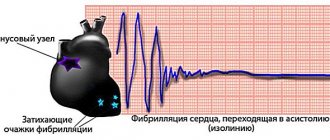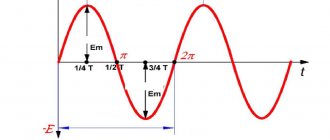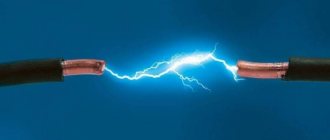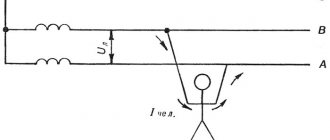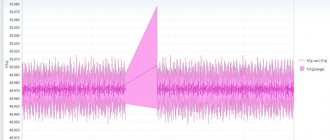According to experienced electricians, electric current is dangerous because it is invisible. Electricity affecting the human body causes severe consequences, including death. It has been established that a current of 50-100 mA is life-threatening, and more than 100 mA is fatal. We are talking about currents passing through a person. In this article we will look at why alternating current is more dangerous than direct current.
High voltage sign
Outcome of electric shock
Depending on the situation, the outcome of shock can be varied. If a person receives a strong electric shock, they may experience problems with circulation and breathing. In severe situations, cardiac fibrillation may begin - the heart muscle begins to twitch chaotically. Since the heart essentially stops pumping, blood flow stops. If first aid is not provided in a timely manner, a person may die.
Most often, electric shocks are observed when people are struck by electric current with a strength of up to 1000 V. Burns can occur when exposed to a current of 1 A or higher. This mainly happens if, when working with a current of more than 1000 V, a person does not follow basic safety rules. The current-carrying part is located at a distance quite close to the human body; a spark discharge occurs between them, which leads to severe burns.
If a person accidentally receives a spark discharge, the current at the moment of connection with the body heats the tissue to 60°. This leads to protein coagulation, and a burn forms on the affected area. Electrical burns are difficult to treat.
Ohm's law
One of the laws of electrical engineering, which was derived through experimental research, is empirical. With its help, a connection is established between the resistance of the conductor, the voltage at its ends and the strength of the current passing through the conductor. Ohm Georg, a German physicist, in 1826 conducted a series of experiments and derived a relationship between these quantities, which can be revealed as follows: the current strength is directly dependent on the potential difference at the ends of the conductor and inversely on its resistance. Ohm's Law Formula:
I = U/R,
Where:
- I – current strength, A;
- U – voltage (potential difference), V;
- R – conductor resistance, Ohm.
An ampere is a unit of electricity in a section of a circuit, obtained by dividing a voltage of 1 volt by a resistance of 1 ohm.
Attention! From this expression, for example, it follows that if, with a constant resistance, the voltage is doubled, then the current will also double. If at a constant voltage value you double the resistance, then it will decrease by half
Mnemonic rule for remembering the formula of Ohm's law
The formula is applied to a section of the circuit through which the movement of electrons occurs in one direction. In the case of alternating electricity with one phase, the formula changes form:
I = U/Z, where:
- I – current strength, A;
- U – potential difference, V;
- Z – total (complex) resistance of the circuit, Ohm.
If the circuit includes, along with active components, also reactive components, the direction of movement of electrons has harmonic oscillations, then this law describes the dependence of complex quantities.
Signs of burns from electrical shock
There is such a thing as electric tags. These are dead patches of yellowish skin that look like calluses. If the current penetrates deep into the skin, the body tissue will die over time.
Signs of an electrical burn:
- the skin in the area of impact turned red;
- burns with the formation of blisters began to appear at the site of the outbreak;
- the tissues at the site of impact were charred;
- Pieces of metal could get into the skin when straightening clothes.
The most dangerous thing is if the electric shock hits the area:
- temples;
- backs;
- hands;
- shins;
- back of the head;
- neck.
Providing first aid to victims
The life and health of an injured person depends on how quickly and correctly first aid is provided.
Artificial respiration
First of all, to save the life of the victim, the following actions must be taken:
- Immediately remove the person from exposure to the current. If this fails, then it is necessary to cut or chop the current-carrying conductor (cable or wire). Wearing rubber shoes and dielectric gloves, the cable is cut with an ax with a dry wooden handle.
- The body must be pulled out of the danger zone. If possible, use rubber mats, dry wooden flooring, etc.
- If the victim remains conscious, he must be placed on a stretcher, covered warmly and given 20 heart drops. After this, load the stretcher with the victim into the ambulance.
- When it is discovered that the injured person is unconscious, it is necessary to free the body from tight clothing in the chest area, provide an influx of fresh air and cover it with a warm blanket. You need to bring a cotton swab with ammonia to your nose, rub it on your temples and wait for the ambulance to arrive.
- If there are visible signs of clinical death, you urgently need to urgently perform an indirect cardiac massage, while at the same time performing artificial respiration every 15 seconds - “mouth to mouth”. After exhaling, you need to press the sternum 3-4 times. The process is repeated until breathing and cardiac activity are completely restored.
All human life is surrounded by carriers of electrical energy. Therefore, you need to understand the dangers of contact with sources of electric current. You should always remember about safe behavior when handling various current conductors and know how to provide first aid.
Classification of electric current according to the degree of impact on humans
Electric current varies in its degree of impact on humans. He can be:
- tangible;
- unreleased;
- fibrillation.
An electric current is called palpable, and when struck, a person feels obvious irritation. You can feel a current shock at 0.6 mA.
Non-releasing - electric current that causes involuntary convulsive movements of the limbs that touch the exposed wires.
Alternating current, passing through the cells of the human body, delivers impulses that cause a person to experience an adhesion effect.
Fibrillation current when struck causes problems with the cardiac system. At this moment the person may die from cardiac arrest.
Dangerous current
Depending on the situation, voltages of different magnitudes can pass through the human body, which means that the consequences of the damage can be diverse. You need to know that a current that is dangerous to a person has a current strength of more than 15 mA, at which a person is not able to free himself without outside help. A current of 50 mA can cause severe damage to health, and a current of 100 mA when exposed for 1-2 seconds is considered fatal and usually causes cardiac arrest.
The most dangerous current for humans is alternating current, the frequency of which is more than 50-500 Hz. If its value is about 9 mA, a person is able to free himself from the source of damage (wire). It is necessary to understand that direct current is also dangerous for the life and health of people, and you can get rid of it only if it does not exceed 20-25 mA.
Summing up
As you can see, the current component affecting a person determines which situations are considered dangerous and which are not. But, at the same time, without a potential difference, electric current will not flow through a person at all. A direct example of this is performing work under voltage, when a person freely touches the wires, and the deadly electricity does not hit him. The problem is solved by an insulating insert between the ground and a person’s feet, which breaks the electrical circuit.
Rice. 4. Working under voltage from an insulated tower
In addition, there is a whole range of electrical installations that are safe due to low voltage power supply. Thus, levels of no more than 42 V AC and 100 V DC can be considered potentially safe, and all others refer to dangerous or high voltage. But don’t tempt fate, it’s better to play it safe and use personal protective equipment, and in any unclear situation, refrain from interacting with an electrical installation, broken wires or the body of a broken household appliance connected to the network.
What alternating current is dangerous for humans?
People who regularly work with electronic and electrical devices know what alternating and direct current is. But not all of them have information about which of them is more dangerous for humans.
It is worth understanding that electricity poses a danger to people; this is influenced by many factors. Such as:
- how long the contact lasted;
- the paths along which the current passed through the body;
- how strong the blow was;
- resistance of the human body.
Alternating current is considered dangerous to humans. Causes:
- Direct current will have the same force on the human body if it is 3 times greater than alternating current. This happens because alternating current excites the nerves much more and stimulates the muscles and heart.
- Death due to electric shock usually results from cardiac arrest. The risk of death is most often present when working with alternating current.
- The resistance produced by the human body is higher than direct current, and the higher the frequency, the lower the resistance.
From this it becomes clear that alternating current is much more dangerous to human life than direct current.
History of discovery
The history of studying this phenomenon goes back to the very distant past. So, the first to mention it was the ancient philosopher Thales of Miletus. It was he who, back in the 7th century BC, noticed that amber rubbed on a piece of wool began to attract objects of light weight. However, the development of research in this area stopped there for almost 2.5 millennia. Only in the 17th century was the term first introduced to denote the phenomenon discovered by the Greek philosopher (1600, W. Gilbert), then active research began to study the nature of electricity and the possibilities of its use for the benefit of humanity.
The most significant discoveries and inventions were the following:
- 1633 - German engineer Otto von Guericke invents the world's first electrostatic machine, which made it possible to observe various types of interaction of electric charges (repulsion and attraction);
- 1729 - the English scientist Stephen Gray, as a result of his research and experiments on the transmission of electricity over significant distances, discovered that different materials transmit it differently through their thickness (have different electrical conductivity);
- 1745 - Dutch scientist Pieter van Muschenbrouck invents the world's first electrical charge storage device (the simplest capacitor) - the Leyden jar.
- 1800 - Italian scientist Alessandro Volta invented the first current source - a galvanic cell consisting of round zinc and silver plates, folded alternately in a column and separated from each other by paper soaked in a saline solution.
- 1820 – Danish physicist Hans Oersted discovered the electromagnetic interaction between electric charges and charged particles of different signs.
- 1831 – Michael Faraday discovers the phenomenon of electromagnetic induction
- 1880 - Frenchman Pierre Curie discovers the effect of a crystal generating an electric charge when it is compressed or otherwise changed (piezoelectricity).
At the end of the 19th and 20th centuries, one of the most famous and mysterious scientists who studied what electricity is and created many inventions was Nikola Tesla.
What kind of direct current is dangerous for humans?
Both alternating and direct current pose a danger to humans. The only thing is that variable is 35 times more dangerous than constant. It is worth knowing that a direct current of 50 mA is considered safe, while for alternating current this mark is only 10 mA. But the main thing is that the danger of any current depends precisely on its intensity.
Counts:
- at voltages up to 400 V, alternating current is more dangerous;
- if the voltage is 500 V, the effect of the current is the same;
- at voltages above 500 V, direct current is more dangerous.
Alternating current flows intermittently, while direct current flows continuously. When struck by alternating current, there is a chance of breaking away from the source of shock. It is worth understanding that the danger is represented not only by the type of current that struck the person, but also by which area was struck. The most dangerous path of current is through the heart, brain, and lungs.
Direct current is dangerous for humans, as an electric shock can cause burns or breathing problems.
Video
Differential automatic machine reliable protection of electrical circuits and people
XXI CENTURY Candy Fudge Scented water
266 ₽ More details
Video baby monitor Motorola MBP36S (white)
12900 ₽ More details
Men's low shoes
What organs are affected by electricity?
How severely a person's body is affected at the moment of electric shock depends on the path along which the current passed. In practice, there are several options by which current can pass through the body:
- If a person picks up a bare live wire with both hands. This path is called hand-to-hand and passes between the hands, affecting the respiratory organs and the heart.
- When a person stands on the ground, he touches the exposed wire with his hand. The path is called arm - legs, the current penetrates through the internal organs of breathing and heart.
- The worker stands with his feet on the ground, in the area of the faulty grounding. The legs receive a shock. The path of the current is called leg-leg.
- When a person accidentally touches a conductive part with his head. The path can be called head - hand, head - feet.
- The most dangerous paths through which current can pass through the body are those that involve the most important systems for a person.
Rules for moving in the step voltage zone
The general provisions for the presence of people in the territory with SN are recognized. They are very simple and must be followed. The rules consist of 3 main points:
- It is strictly forbidden to be in a hazardous area without basic and additional electrical protection equipment. These include dry shoes with thick rubber soles, rubber gloves, and a dielectric rod (dry wooden stick or strip).
- If a lying wire or cable is visually visible, then you should not approach it closer than 8-10 meters. This safe distance was determined by experts when a conductor with a voltage of 1 thousand volts falls.
- When a person is caught by the unexpected appearance of SN, he needs to leave the dangerous territory and move with a shuffling step. The heel of one foot, keeping up with the ground, fits tightly to the toe of the other foot. Moving in this way is the safest way out of the dangerous zone of the ShN.
Rules

